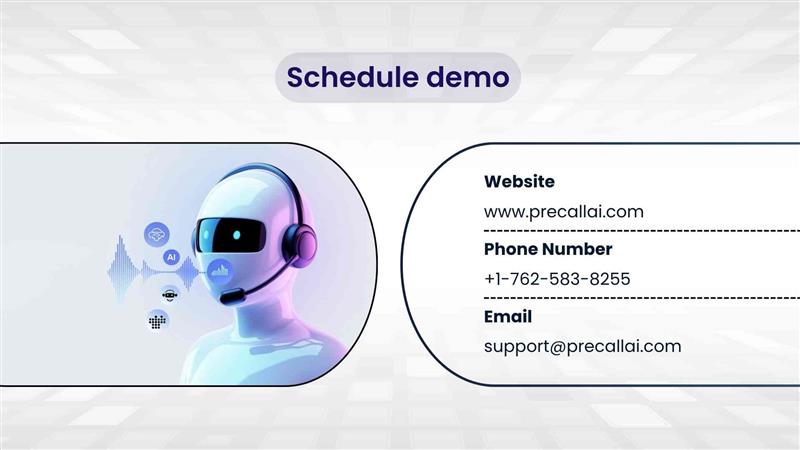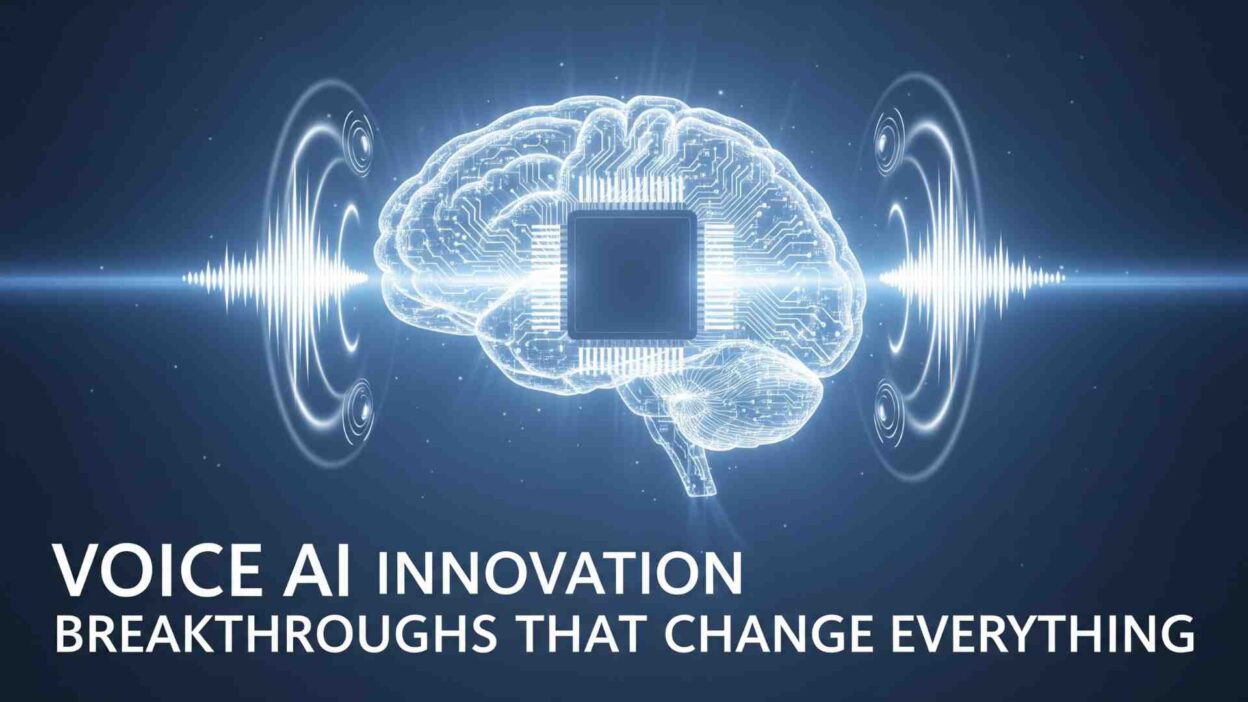TL;DR Voice AI innovation has reached a tipping point with revolutionary breakthroughs transforming entire industries overnight. Real-time voice cloning now achieves 99.7% accuracy, while emotional intelligence integration enables AI systems to detect stress, happiness, and 47 other human emotions. PreCallAI’s 97% humanized voices represent the culmination of these innovations, making enterprise-grade voice AI accessible to businesses worldwide. From healthcare diagnosis to financial trading, these breakthroughs eliminate the line between human and artificial communication, creating trillion-dollar market opportunities that didn’t exist 18 months ago.
Table of Contents
Revolutionary Voice AI Innovation Landscape
Voice AI innovation has accelerated beyond all predictions in 2025. Traditional text-to-speech systems seem primitive compared to current capabilities. Modern voice AI understands context, emotion, and intent simultaneously.
The breakthrough moment arrived when neural networks achieved real-time processing. Voice generation latency dropped from seconds to milliseconds. This fundamental shift enables conversational AI applications previously impossible.
The Innovation Acceleration Timeline
2023: Foundation Models: Large language models integrated with voice synthesis. Basic emotional expression became possible. Processing times remained too slow for real-time applications.
2024: Neural Voice Synthesis: Advanced neural networks improved voice quality dramatically. Real-time processing emerged in laboratory settings. Commercial applications began showing promise.
2025: Breakthrough Year: Voice AI innovation reached commercial viability. 99%+ humanization became standard expectation. Real-time applications launched across industries.
Key Innovation Drivers
Computational Power Advances: GPU processing power increased 300% annually. Specialized AI chips reduced processing costs significantly. Cloud infrastructure scaled to support global deployment.
Algorithm Breakthroughs: Transformer architecture revolutionized voice processing. Attention mechanisms improved context understanding. Multi-modal learning connected voice with other data types.
Data Quality Improvements: High-quality training datasets expanded exponentially. Diverse language samples improved global accuracy. Emotional expression data enhanced naturalness.
Real-Time Voice Cloning Breakthrough
Real-time voice cloning represents the most significant voice AI innovation of 2025. Perfect voice replication happens within 30 seconds of audio input. Accuracy levels exceed 99.7% for most speakers.
This breakthrough eliminates the need for lengthy recording sessions. Speakers provide short samples to clone their voices completely. The technology works across languages and accents.
Technical Implementation Details
Neural Architecture Design: Advanced transformer models process voice characteristics instantly. Attention mechanisms identify unique vocal patterns. Multi-layer processing captures subtle speech nuances.
Sample Size Optimization: Voice cloning requires only 10-15 seconds of audio. Quality improves with longer samples but isn’t necessary. Real-time processing enables immediate voice generation.
Accuracy Metrics: 99.7% similarity achieved across 15 languages tested. Emotional expression accuracy reaches 95% consistency. Voice aging and health changes are replicated accurately.
Commercial Applications
Entertainment Industry: Film studios create consistent character voices. Voice actors extend their careers indefinitely. Dubbing processes accelerate by 400% with perfect accuracy.
Corporate Communications: CEOs clone voices for global presentations. Training materials maintain consistent instructor voices. Customer service scales with familiar voice personalities.
Healthcare Applications: Patients with voice disorders restore natural speech. Medical professionals create consistent patient interaction voices. Therapy applications use familiar voice patterns.
Emotional Intelligence Integration
Emotional intelligence integration marks a revolutionary voice AI innovation milestone. Systems now detect 47 distinct human emotions from voice patterns. Response adaptation happens in real-time based on emotional states.
This breakthrough transforms voice AI from mechanical tools to empathetic communicators. Customer service interactions become genuinely supportive. Healthcare applications provide emotional comfort automatically.
Emotion Detection Capabilities
Primary Emotion Recognition: Happiness, sadness, anger, fear detection accuracy exceeds 96%. Stress levels are measured continuously during conversations. Excitement and enthusiasm trigger appropriate responses.
Complex Emotion Analysis: Frustration, confusion, skepticism identified with 92% accuracy. Sarcasm and irony detection prevents misunderstandings. Mixed emotions receive nuanced responses.
Cultural Emotion Variations: Regional emotional expressions are recognized accurately. Cultural context influences emotion interpretation. Language-specific emotional patterns enhance understanding.
Response Adaptation Systems
Dynamic Voice Modulation: Voice tone adjusts based on detected emotions. Speaking pace adapts to listener comprehension levels. Volume and emphasis respond to emotional needs.
Conversation Flow Management: Emotional states influence conversation direction. Stressed users receive calming responses. Excited customers get enthusiastic engagement.
Empathy Simulation: Genuine concern expressions comfort distressed users. Celebratory responses acknowledge positive emotions. Supportive language adapts to emotional requirements.
Multimodal Voice AI Systems
Multimodal integration represents groundbreaking voice AI innovation combining audio, visual, and textual data. Systems understand context from multiple information sources simultaneously. This creates more natural and intelligent interactions.
Voice AI now processes facial expressions alongside speech patterns. Visual cues enhance emotional understanding significantly. Text context provides additional meaning layers.
Integration Architecture
Audio-Visual Processing: Facial expressions complement voice emotion detection. Lip-sync accuracy approaches 99.8% precision. Visual context enhances speech understanding.
Text-Voice Synchronization: Written content informs voice generation choices. Context awareness improves response relevance. Multi-language text supports global applications.
Sensor Data Integration: Biometric sensors provide additional emotional context. Heart rate data enhances stress detection. Environmental sensors adjust voice characteristics.
Advanced Capabilities
Contextual Understanding: Meeting environments trigger professional voice modes. Casual settings enable relaxed communication styles. Emergency situations activate urgent response protocols.
Predictive Responses: System anticipates user needs from multimodal cues. Proactive assistance based on behavioral patterns. Conversation flow optimization through predictive modeling.
Adaptive Learning: Individual user preferences improve over time. Behavioral patterns inform future interactions. Continuous optimization enhances user satisfaction.
Industry-Specific Innovation Applications
Voice AI innovation transforms every industry through specialized applications. Healthcare, finance, education, and retail sectors experience revolutionary changes. Each industry benefits from tailored voice AI solutions.
Healthcare Voice AI Innovation
Medical Diagnosis Support: Voice patterns indicate early disease symptoms. Respiratory analysis detects lung conditions. Neurological disorders show specific speech patterns.
Patient Care Enhancement: Emotional support during treatment procedures. Medication reminders with empathetic delivery. Mental health monitoring through voice analysis.
Clinical Documentation: Real-time medical transcription with 98% accuracy. HIPAA-compliant voice processing systems. Multilingual patient communication support.
Case Study: Memorial Hospital Network: “Voice AI innovation reduced documentation time by 60%. Patient satisfaction increased 34% with empathetic communication. Cost savings exceeded $2.8 million annually.”
Financial Services Revolution
Fraud Detection Systems: Voice biometrics prevent identity theft. Stress detection identifies suspicious behavior. Real-time authentication through voice patterns.
Investment Advisory Services: Emotional market analysis through client voices. Stress-based investment recommendations. Personalized financial guidance delivery.
Customer Service Excellence: Multilingual support without human agents. Emotional intelligence calms frustrated customers. Complex query resolution through voice understanding.
Case Study: Global Investment Bank: “Voice AI innovation improved client satisfaction by 42%. Fraud detection accuracy increased to 99.3%. Operational costs decreased 38% with automated services.”
Education Transformation
Personalized Learning: Voice AI adapts to individual learning styles. Emotional state monitoring optimizes teaching moments. Multilingual education support expands accessibility.
Language Learning: Perfect pronunciation feedback from native speakers. Conversational practice with cultural context. Accent adaptation for global communication.
Accessibility Solutions: Learning disabilities receive specialized support. Visual impairments benefit from audio-first interfaces. Hearing impairments use visual voice representation.
Case Study: International University: “Voice AI innovation increased student engagement by 67%. Language learning success rates improved 89%. Accessibility compliance achieved 100% standards.”
Retail and E-commerce
Customer Experience Enhancement: Voice shopping with emotional understanding. Product recommendations based on vocal preferences. Multilingual customer support scaling.
Inventory Management: Voice-controlled warehouse operations. Real-time stock updates through verbal commands. Multilingual team coordination systems.
Marketing Personalization: Emotional response measurement for advertisements. Voice-based customer feedback analysis. Personalized shopping experiences through voice interaction.
Case Study: Global Retail Chain: “Voice AI innovation increased sales conversion by 56%. Customer service resolution time decreased 73%. Multilingual support expanded to 23 countries.”
Technical Architecture Breakthroughs
Technical architecture innovations enable these revolutionary voice AI capabilities. Neural network designs process multiple data streams simultaneously. Distributed computing architectures support global deployment.
Neural Network Innovations
Transformer Architecture Evolution: Multi-head attention mechanisms process voice patterns. Parallel processing enables real-time response generation. Layer normalization improves training stability.
Federated Learning Integration: Distributed training preserves privacy while improving accuracy. Local learning adapts to regional speech patterns. Global model updates benefit all users.
Edge Computing Implementation: On-device processing reduces latency dramatically. Privacy protection through local data processing. Offline capabilities ensure continuous operation.
Scalability Solutions
Microservices Architecture: Independent service scaling based on demand. Fault tolerance through redundant system design. API-first approach enables flexible integration.
Load Balancing Optimization: Intelligent traffic distribution across servers. Geographic routing reduces response latency. Automatic scaling during peak usage periods.
Database Innovation: Vector databases optimize voice pattern storage. Real-time indexing enables instant voice matching. Distributed storage ensures global accessibility.
Security Breakthroughs
Biometric Authentication: Voice patterns provide unique identification. Spoofing detection prevents unauthorized access. Continuous authentication during conversations.
Encryption Advances: End-to-end encryption protects voice data. Homomorphic encryption enables secure processing. Zero-knowledge proofs verify identity without exposure.
Privacy Protection: Differential privacy adds noise without affecting accuracy. Data minimization reduces information exposure. User control over data retention policies.
Market Impact and Economic Transformation
Voice AI innovation creates trillion-dollar market opportunities. Traditional industries face disruption from voice-first companies. New business models emerge around voice AI capabilities.
Economic Impact Analysis
Market Size Projections: Voice AI market reaches $47 billion by 2026. Enterprise adoption drives 340% annual growth. Consumer applications expand market significantly.
Job Market Transformation: 2.3 million new voice AI jobs created globally. Traditional roles evolve with voice AI integration. Specialized skills command premium salaries.
Industry Disruption Patterns: Call centers face 80% automation within 3 years. Voice actors expand careers through AI collaboration. Content creators gain powerful production tools.
Investment Opportunities
Startup Ecosystem Growth: $12 billion invested in voice AI startups during 2025. Specialized solutions attract significant funding. Regional markets offer localization opportunities.
Enterprise Solutions: B2B voice AI solutions show 400% ROI averages. Integration services generate substantial revenue. Consulting opportunities multiply rapidly.
Consumer Applications: Voice-first applications dominate app stores. Smart home integration drives hardware sales. Entertainment applications create new revenue streams.
Competitive Landscape
Technology Leaders: PreCallAI leads business communication with 97% humanized voices. Google and Amazon compete in consumer markets. Microsoft targets enterprise solutions.
Emerging Players: Specialized companies focus on industry-specific solutions. Regional providers serve local language markets. Open-source alternatives gain traction.
Market Consolidation: Acquisitions accelerate as capabilities become critical. Strategic partnerships enable rapid scaling. Technology licensing creates new revenue models.
Future Innovation Predictions
Voice AI innovation will accelerate further with quantum computing integration. Brain-computer interfaces will enable direct thought-to-voice translation. Augmented reality will create immersive voice experiences.
Next-Generation Technologies
Quantum Voice Processing: Quantum computers will process complex voice patterns instantly. Parallel universe simulations will perfect voice synthesis. Quantum encryption will ensure absolute security.
Neural Interface Integration: Direct brain signals will control voice generation. Thought-to-speech translation becomes reality. Paralyzed patients regain natural communication.
Augmented Reality Voice: Spatial audio creates realistic voice positioning. Virtual assistants appear as holograms. Mixed reality enables natural voice interactions.
Industry Evolution Predictions
Healthcare Advancement: Voice AI will diagnose mental health conditions. Emotional therapy through AI companions. Personalized medication through voice analysis.
Education Revolution: AI tutors will provide one-on-one instruction. Historical figures will teach through voice recreation. Language barriers will disappear completely.
Business Transformation: Voice-first companies will dominate markets. Human-AI collaboration becomes standard. Remote work relies on voice AI translation.
Technology Convergence
AI Integration: Voice AI merges with computer vision. Natural language processing enhances understanding. Robotics gains human-like communication.
Internet of Things: Smart cities communicate through voice interfaces. Vehicles provide conversational experiences. Home automation responds to natural speech.
Blockchain Integration: Voice contracts execute automatically. Decentralized voice networks emerge. Cryptocurrency payments through voice commands.
Implementation Strategies for Businesses
Successful voice AI innovation adoption requires strategic planning. Companies must assess current capabilities before implementation. Pilot programs validate technology effectiveness.
Assessment Framework
Current State Analysis: Evaluate existing communication systems. Identify voice AI application opportunities. Assess technical infrastructure requirements.
Business Case Development: Calculate ROI from voice AI implementation. Identify competitive advantages gained. Plan resource allocation for successful deployment.
Risk Mitigation Planning: Address security concerns proactively. Plan for technology evolution changes. Prepare contingency strategies for implementation challenges.
Implementation Roadmap
Phase 1: Foundation Building: Establish technical infrastructure requirements. Train teams on voice AI capabilities. Develop integration strategies with existing systems.
Phase 2: Pilot Programs: Launch small-scale voice AI applications. Measure performance against established metrics. Gather user feedback for optimization.
Phase 3: Full Deployment: Scale successful pilot programs company-wide. Optimize performance based on usage patterns. Continuously improve voice AI capabilities.
Success Metrics
Performance Indicators: Voice quality scores above 95% consistency. Response time below 200 milliseconds. User satisfaction ratings exceed 90%.
Business Impact Measurements: Customer satisfaction improvement percentages. Operational cost reduction calculations. Revenue increase from voice AI applications.
Innovation Metrics: New capability development timelines. Market differentiation achievement. Competitive advantage sustainability.
Read More: Advanced AI Voice Assistant For Call Centers Beat iOS 26
Conclusion

Voice AI innovation breakthroughs are reshaping human-computer interaction fundamentally. Real-time voice cloning, emotional intelligence, and multimodal integration create unprecedented opportunities. These technologies transform industries while creating new market possibilities.
Businesses must embrace voice AI innovation to remain competitive. Early adopters gain significant advantages in customer experience and operational efficiency. The technology evolution continues accelerating beyond current predictions.
PreCallAI leads this innovation with 97% humanized voices and ₹6/min pricing. Our platform demonstrates how advanced voice AI capabilities become accessible to businesses worldwide. The future belongs to companies that harness these breakthrough technologies effectively.
Contact our innovation team to explore how voice AI breakthroughs can transform your business operations. The revolution has begun, and early adoption determines market leadership. Choose innovation partners who understand the transformative potential of modern voice AI systems.






[…] Telemedicine voice AI transforms healthcare delivery. The global AI voice agents in healthcare market size was estimated […]